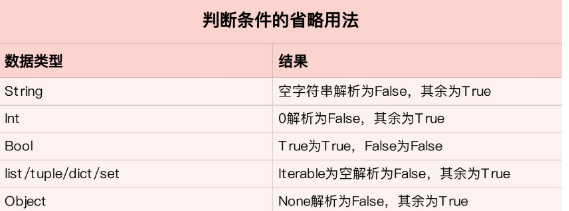【Python学习】条件和循环
| 阿里云国内75折 回扣 微信号:monov8 |
| 阿里云国际,腾讯云国际,低至75折。AWS 93折 免费开户实名账号 代冲值 优惠多多 微信号:monov8 飞机:@monov6 |
前言
往期文章
【Python学习】列表和元组
【Python学习】字典和集合
条件控制
简单来说当判断的条件为真时执行某种代码逻辑这就是条件控制。
那么在讲条件控制之前可以给大家讲一个程序员当中流传的比较真实的一个例子
说有一天一个程序员他的媳妇让他去出去买两个包子那出去之前他媳妇这么跟他说的说老公你出去给我买两个包子
如果看见卖西瓜的就买一个回来。
结果这个程序员回来了买一个包子。结果媳妇给他一顿揍。
然后问他为啥你为啥就买一个包子回来他回答他媳妇说我看见了卖西瓜的所以买了一个包子。
其实这个就是条件控制一个典型的一个生活化的一个说明场景
条件语句
条件控制就是我们常见的的if else
# y = |x|
if x < 0:
y = -x
else:
y = x
在条件语句后面加上 冒号
python不支持switch语句但是支持elif
if condition_1:
statement_1
elif condition_2:
statement_2
...
elif condition_i:
statement_i
else:
statement_n
不少人喜欢省略半段的条件就像这样
if s: # s is a string
...
if l: # l is a list
...
if i: # i is an int
...
...

循环语句
一般通过for循环和while循环实现
l = [1, 2, 3, 4]
for item in l:
print(item)
在python数据结构只要时可迭代对象如列表集合等等就可以遍历
for item in <iterable>:
...
但是字典本身只有键时课迭代的如何要遍历字典的值和键值对要通过内置的函数values() 和items() 实现
d = {'name': 'jason', 'dob': '2000-01-01', 'gender': 'male'}
for k in d: # 遍历字典的键
print(k)
name
dob
gender
for v in d.values(): # 遍历字典的值
print(v)
jason
2000-01-01
male
for k, v in d.items(): # 遍历字典的键值对
print('key: {}, value: {}'.format(k, v))
key: name, value: jason
key: dob, value: 2000-01-01
key: gender, value: male
当然可以通过索引来遍历元素
l = [1, 2, 3, 4, 5, 6, 7]
for index in range(0, len(l)):
if index < 5:
print(l[index])
别忘了还有一个更重要的enumerate() 函数
l = [1, 2, 3, 4, 5, 6, 7]
for index, item in enumerate(l):
if index < 5:
print(item)
在循环语句中要通过continue 或break 一起使用
continue就是让程序跳过当前这层循环继续执行下面的循环
break 则是指完全跳出所在的整个循环体
现在找出价格小于1000颜色不是红色的产品名称和颜色组合如果不用continue
# name_price: 产品名称 (str) 到价格 (int) 的映射字典
# name_color: 产品名字 (str) 到颜色 (list of str) 的映射字典
for name, price in name_price.items():
if price < 1000:
if name in name_color:
for color in name_color[name]:
if color != 'red':
print('name: {}, color: {}'.format(name, color))
else:
print('name: {}, color: {}'.format(name, 'None'))
共用了5层for 或if 的嵌套
加上了continue只有3层
# name_price: 产品名称 (str) 到价格 (int) 的映射字典
# name_color: 产品名字 (str) 到颜色 (list of str) 的映射字典
for name, price in name_price.items():
if price >= 1000:
continue
if name not in name_color:
print('name: {}, color: {}'.format(name, 'None'))
for color in name_color[name]:
if color == 'red':
continue
print('name: {}, color: {}'.format(name, color))
while
l = [1, 2, 3, 4]
index = 0
while index < len(l):
print(l[index])
index += 1
那么在什么场合使用for和continue
如果只是遍历已知的集合找出满足条件的元素使用for更加的简洁
如果需要在满足某个条件前要不停的重复操作并且没有特定的集合来遍历
例如
while True:
try:
text = input('Please enter your questions, enter "q" to exit')
if text == 'q':
print('Exit system')
break
...
...
print(response)
except as err:
print('Encountered error: {}'.format(err))
break
for 循环和while循环的效率问题
i = 0
while i < 1000000
i += 1
for i in range(0, 1000000):
pass
range函数直接时C语言写的调用的速度非常快for循环的效率更高
对于有些大神直接写成一行操作
expression1 if condition else expression2 for item in iterable
分解成
for item in iterable:
if condition:
expression1
else:
expression2
如何没有else
expression for item in iterable if condition
现在绘制 y = 2*|x| + 5 的函数图像
只需一行
y = [value * 2 + 5 if x > 0 else -value * 2 + 5 for value in x]
在处理字符串时将文件逐行读取按照逗号分隔单词去掉首位空字符过滤小于3的单词最后返回单词组成的列表
text = ' Today, is, Sunday'
text_list = [s.strip() for s in text.split(',') if len(s.strip()) > 3]
print(text_list)
['Today', 'Sunday']
给定两个列表 x、y要求返回 x、y 中所有元素对组成的元组
[(xx, yy) for xx in x for yy in y if x != y]
l = []
for xx in x:
for yy in y:
if x != y:
l.append((x, y))
最后
刚开始接触Python的宝子有什么不懂的都可以私信我哦
我还准备了大量的免费视频教程PDF电子书籍以及源代码直接在文末名片自取即可哦

